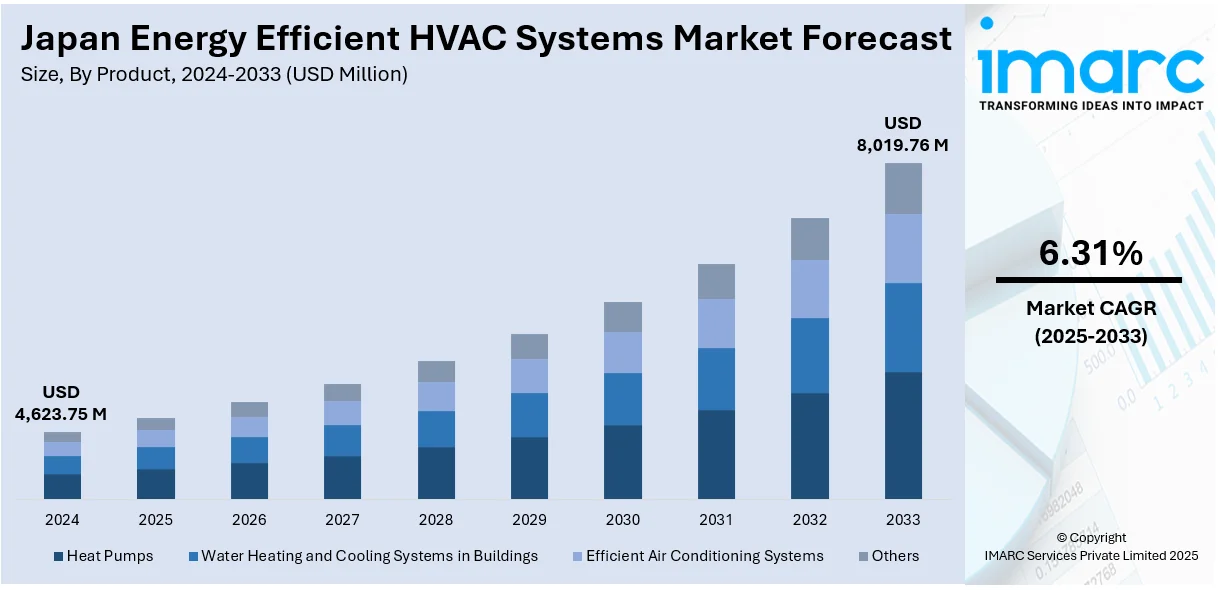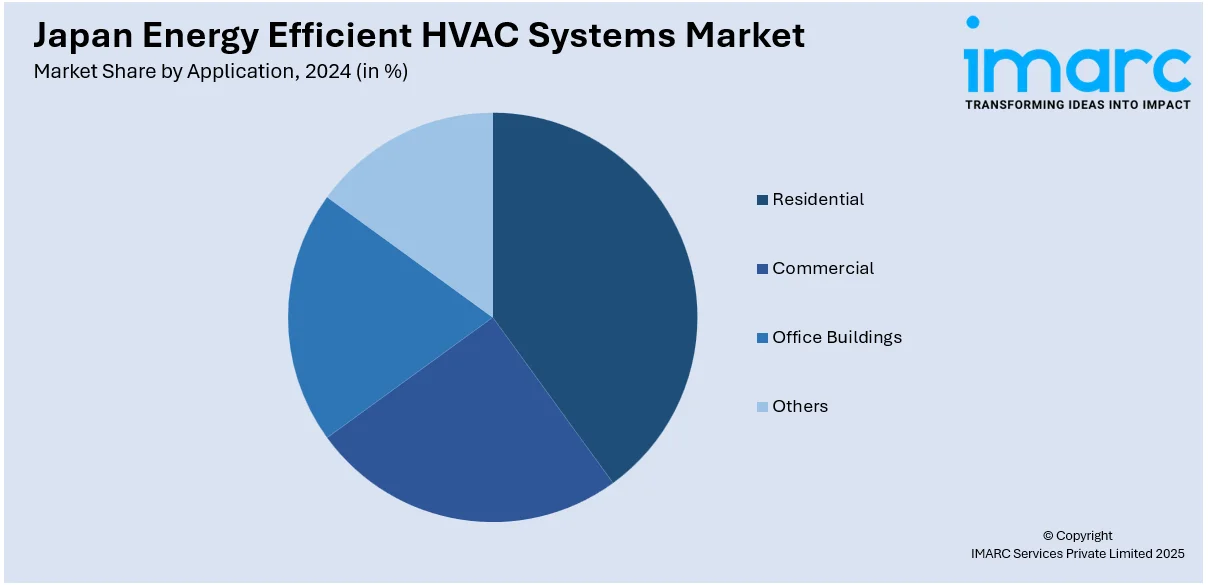
Japan Energy Efficient HVAC Systems Market Size, Share, Trends and Forecast by Product, Application, and Region, 2025-2033
Japan Energy Efficient HVAC Systems Market Overview:
The Japan energy efficient HVAC systems market size reached USD 4,623.75 Million in 2024. Looking forward, IMARC Group expects the market to reach USD 8,019.76 Million by 2033, exhibiting a growth rate (CAGR) of 6.31% during 2025-2033. Government incentives for low-carbon technologies, rising electricity costs, and consumer demand for eco-friendly solutions are driving adoption. Technological innovation, retrofitting of old buildings, and increased commercial sector spending also contribute to the market demand. These drivers collectively support Japan energy efficient HVAC systems market share.
|
Report Attribute
|
Key Statistics
|
|---|---|
|
Base Year
|
2024
|
|
Forecast Years
|
2025-2033
|
|
Historical Years
|
2019-2024
|
| Market Size in 2024 | USD 4,623.75 Million |
| Market Forecast in 2033 | USD 8,019.76 Million |
| Market Growth Rate 2025-2033 | 6.31% |
Japan Energy Efficient HVAC Systems Market Trends:
Integration of Smart Building Technologies
One prominent trend is the integration of smart building technologies into HVAC infrastructure. Building automation systems are increasingly used to monitor and optimize energy usage across commercial and residential spaces. In Japan, the push toward smart cities has encouraged deployment of HVAC systems embedded with IoT sensors and AI algorithms. These components track occupancy, temperature, and humidity to dynamically adjust performance, reducing energy waste. Companies are also investing in centralized HVAC monitoring platforms that provide real-time analytics for proactive maintenance and better control. For instance, in April 2025, Carrier Japan launched Abound HVAC Performance, a digital solution enabling real-time monitoring and predictive maintenance for HVAC systems. Integrated with a 24/365 Command Center, it enhances reliability, energy efficiency, and operational control. The system supports wireless connectivity, alarm management, and compliance with GL-17 refrigerant leak detection standards. Compatible with air- and water-cooled systems, it operates through Carrier’s BluEdge service brand. This innovation reflects Carrier Japan’s strategy to expand data-driven lifecycle services and reduce environmental and operational risks in commercial HVAC operations.

Surge in Heat Pump Adoption
Japan is witnessing an accelerated shift toward heat pumps in both residential and commercial HVAC applications. Heat pumps offer significant energy savings compared to traditional systems, aligning with national decarbonization targets. The Japanese government’s subsidies for energy-efficient home upgrades have also fueled interest in air-source and ground-source heat pumps. Recent advancements in variable-speed compressor technology have improved the adaptability of heat pumps to Japan’s climate zones, ensuring reliable year-round performance. These systems are being adopted not only in new buildings but also in retrofitting projects, supported by initiatives from local prefectures. This increased adoption highlights a growing preference for sustainable HVAC solutions, reinforcing Japan energy efficient HVAC systems market growth over the forecast period. For instance, in May 2024, Midea launched the EVOX G3 heat pump system, featuring the EVOX G3 Heat Pump and the EVOX G3 Air Handling Unit (AHU). Offered in capacities from 1.5 to 5 tons, these units incorporate Enhanced Vapor Injection (EVI) technology and a multi-layer heat exchanger to deliver consistent heating performance without auxiliary support, even under severe weather conditions.
Focus on Eco-Friendly Refrigerants
A shift toward low-global-warming-potential (GWP) refrigerants is shaping HVAC product innovation in Japan. Stricter emissions regulations and Japan’s commitment to the Kigali Amendment have accelerated the phasing out of HFC-based refrigerants. Manufacturers are responding by developing HVAC systems compatible with natural refrigerants like CO₂ and R32. For instance, in March 2024, Panasonic Corporation introduced three commercial air-to-water (A2W) heat pump models that use environmentally friendly natural refrigerant R290, targeting applications in multi-dwelling residences, retail spaces, offices, and other light commercial settings. This transition not only reduces environmental impact but also aligns with global trade compliance and export requirements. Japanese HVAC companies are actively promoting these newer models in both domestic and international markets. Additionally, training programs for HVAC technicians on safe refrigerant handling have expanded, ensuring a smoother industry transition. These efforts contribute significantly to sustainable practices, underscoring their role in Japan energy efficient HVAC systems market growth.
Japan Energy Efficient HVAC Systems Market Segmentation:
IMARC Group provides an analysis of the key trends in each segment of the market, along with forecasts at the country/regional levels for 2025-2033. Our report has categorized the market based on product and application.
Product Insights:
- Heat Pumps
- Water Heating and Cooling Systems in Buildings
- Efficient Air Conditioning Systems
- Others
The report has provided a detailed breakup and analysis of the market based on the product. This includes heat pumps, water heating and cooling systems in buildings, efficient air conditioning systems, and others.
Application Insights:

- Residential
- Commercial
- Office Buildings
- Others
A detailed breakup and analysis of the market based on the application have also been provided in the report. This includes residential, commercial, office buildings, and others.
Regional Insights:
- Kanto Region
- Kansai/Kinki Region
- Central/ Chubu Region
- Kyushu-Okinawa Region
- Tohoku Region
- Chugoku Region
- Hokkaido Region
- Shikoku Region
The report has also provided a comprehensive analysis of all the major regional markets, which include Kanto Region, Kansai/Kinki Region, Central/ Chubu Region, Kyushu-Okinawa Region, Tohoku Region, Chugoku Region, Hokkaido Region, and Shikoku Region.
Competitive Landscape:
The market research report has also provided a comprehensive analysis of the competitive landscape. Competitive analysis such as market structure, key player positioning, top winning strategies, competitive dashboard, and company evaluation quadrant has been covered in the report. Also, detailed profiles of all major companies have been provided.
Japan Energy Efficient HVAC Systems Market News:
- In September 2024, Daikin and Tokyo Tech launched the “Daikin Air Conditioning Technology Collaborative Research Cluster” to advance core AC technologies and support carbon neutrality by 2050. Focus areas include compressor innovation, energy efficiency, and digital transformation in development. The cluster will leverage Tokyo Tech’s research capabilities in motors, compressors, and inverters to create low-impact, high-performance systems.
- In August 2024, Johnson Controls-Hitachi Air Conditioning launched the VG and S Series Centrifugal Chillers in Hong Kong, using low-GWP R513a and ultra-low-GWP R1234ze refrigerants to support carbon neutrality. These energy-efficient systems target commercial applications, while the Hitachi air365 Max Pro and SideSmart™ VRF units enhance cooling performance and lower emissions. With advanced technologies like SmoothDrive 2.0 and modular VRF designs, the company reinforces its commitment to sustainable HVAC solutions.
Japan Energy Efficient HVAC Systems Market Report Coverage:
| Report Features | Details |
|---|---|
| Base Year of the Analysis | 2024 |
| Historical Period | 2019-2024 |
| Forecast Period | 2025-2033 |
| Units | Million USD |
| Scope of the Report |
Exploration of Historical Trends and Market Outlook, Industry Catalysts and Challenges, Segment-Wise Historical and Future Market Assessment:
|
| Products Covered | Heat Pumps, Water Heating and Cooling Systems in Buildings, Efficient Air Conditioning Systems, Others |
| Applications Covered | Residential, Commercial, Office Buildings, Others |
| Regions Covered | Kanto Region, Kansai/Kinki Region, Central/Chubu Region, Kyushu-Okinawa Region, Tohoku Region, Chugoku Region, Hokkaido Region, Shikoku Region |
| Post-Sale Analyst Support | 10-12 Weeks |
| Delivery Format | PDF and Excel through Email (We can also provide the editable version of the report in PPT/Word format on special request) |
Key Questions Answered in This Report:
- How has the Japan energy efficient HVAC systems market performed so far and how will it perform in the coming years?
- What is the breakup of the Japan energy efficient HVAC systems market on the basis of product?
- What is the breakup of the Japan energy efficient HVAC systems market on the basis of application?
- What is the breakup of the Japan energy efficient HVAC systems market on the basis of region?
- What are the various stages in the value chain of the Japan energy efficient HVAC systems market?
- What are the key driving factors and challenges in the Japan energy efficient HVAC systems market?
- What is the structure of the Japan energy efficient HVAC systems market and who are the key players?
- What is the degree of competition in the Japan energy efficient HVAC systems market?
Key Benefits for Stakeholders:
- IMARC’s industry report offers a comprehensive quantitative analysis of various market segments, historical and current market trends, market forecasts, and dynamics of the Japan energy efficient HVAC systems market from2019-2033.
- The research report provides the latest information on the market drivers, challenges, and opportunities in the Japan energy efficient HVAC systems market.
- Porter's five forces analysis assist stakeholders in assessing the impact of new entrants, competitive rivalry, supplier power, buyer power, and the threat of substitution. It helps stakeholders to analyze the level of competition within the Japan energy efficient HVAC systems industry and its attractiveness.
- Competitive landscape allows stakeholders to understand their competitive environment and provides an insight into the current positions of key players in the market.
Need more help?
- Speak to our experienced analysts for insights on the current market scenarios.
- Include additional segments and countries to customize the report as per your requirement.
- Gain an unparalleled competitive advantage in your domain by understanding how to utilize the report and positively impacting your operations and revenue.
- For further assistance, please connect with our analysts.
 Request Customization
Request Customization
 Speak to an Analyst
Speak to an Analyst
 Request Brochure
Request Brochure
 Inquire Before Buying
Inquire Before Buying




.webp)




.webp)












